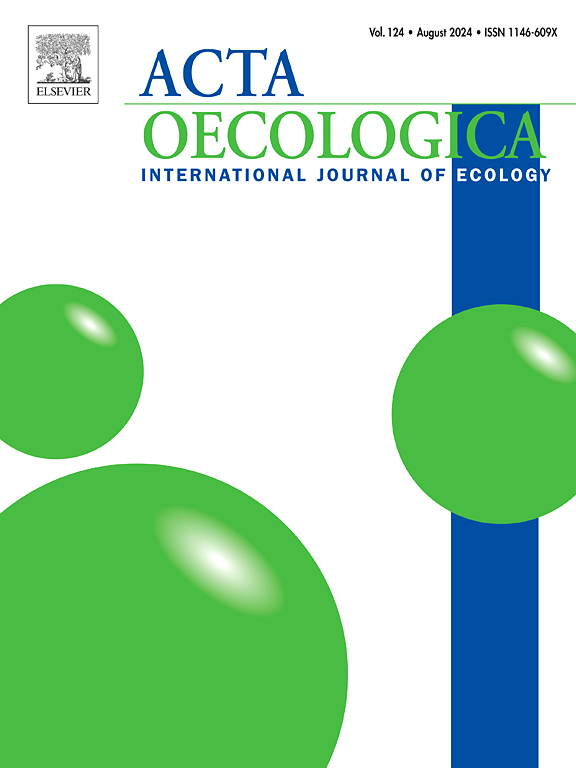生境选择作为生境变异的减少
IF 1.3
4区 环境科学与生态学
Q3 ECOLOGY
Acta Oecologica-International Journal of Ecology
Pub Date : 2025-07-05
DOI:10.1016/j.actao.2025.104103
引用次数: 0
摘要
当生物选择栖息地时,它们可能会减少它们相对于周围环境所经历的环境差异。这种差异可以揭示生物的栖息地偏好和感知范围,特别是当跨越空间和时间尺度进行检查时。为了验证生境差异是否能提供这样的理解,我们以加拿大安大略省中部的成年雌性带gps项圈白尾鹿(Odocoileus virginianus)为研究对象,应用地质统计学方法分析了生境可用性和利用的差异。首先,为了量化利用和可用性,我们在2022年5 - 6月期间测量了鹿使用地点的植被,以及一般环境,然后应用主成分分析(PCA)捕捉植被条件的主要梯度。其次,为了确定生境选择,我们在植被特征的均值和方差上测试了利用和可利用之间的差异。最后,为了描述方差在不同尺度上的变化,我们构建了空间和时间方差图。在主成分分析的前两个轴上,我们发现鹿选择的牧草丰度更高,冠层闭合变化较小。在空间上,对冠层方差减小的选择与尺度(50 ~ 1000 m)无关,表明鹿的感知能力可能超过该尺度。随着时间的推移,鹿在短滞后(4-12 h)的饲料丰度变化呈上升趋势,与运动更为线性的时期(6-10 h)相似。因此,鹿选择了方差较小的栖息地,而没有选择不成比例的栖息地。我们认为,减少方差的选择是生境选择的一个基本特性,其尺度依赖性可以用地质统计学来揭示。本文章由计算机程序翻译,如有差异,请以英文原文为准。
Habitat selection as a reduction in habitat variance
When organisms select habitat, they may lessen the environmental variance they experience relative to their surroundings. Such discrepancies in variance could reveal organisms’ habitat preferences and perceptual ranges, particularly when examined across spatial and temporal scales. To test whether habitat variance might provide such understanding, we applied geostatistics to the variance in availability and use of habitat by GPS-collared adult female white-tailed deer (Odocoileus virginianus) in central Ontario, Canada. First, to quantify use and availability, we measured vegetation at the locations used by deer during May–June 2022, as well as in the general environment, then applied principal components analysis (PCA) to capture the major gradients in vegetation conditions. Second, to identify habitat selection, we tested for differences between use and availability in both the means and variance of vegetation characteristics. Finally, to depict how variance changed across scales, we constructed spatial and temporal variograms. Based on the first two axes of the PCA, we found that deer selected greater abundance in forage and lower variation in canopy closure. Across space, the selection for reduced variance in canopy appeared largely independent of scale (50–1000 m), implying that the perception capacity of deer may exceed this range. Across time, deer exhibited rising variance in forage abundance at short lags (4–12 h), resembling the periods (6–10 h) when movements were more linear. Deer thus selected for lower variance of habitat without selecting for disproportionate levels of habitat. We propose that selection for diminished variance is a fundamental property of habitat selection, whose scale-dependence might be uncovered with geostatistics.
求助全文
通过发布文献求助,成功后即可免费获取论文全文。
去求助
来源期刊
CiteScore
3.60
自引率
0.00%
发文量
57
审稿时长
>0 weeks
期刊介绍:
Acta Oecologica is venue for the publication of original research articles in ecology. We encourage studies in all areas of ecology, including ecosystem ecology, community ecology, population ecology, conservation ecology and evolutionary ecology. There is no bias with respect to taxon, biome or geographic area. Both theoretical and empirical papers are welcome, but combinations are particularly sought. Priority is given to papers based on explicitly stated hypotheses. Acta Oecologica also accepts review papers.

 求助内容:
求助内容: 应助结果提醒方式:
应助结果提醒方式:


